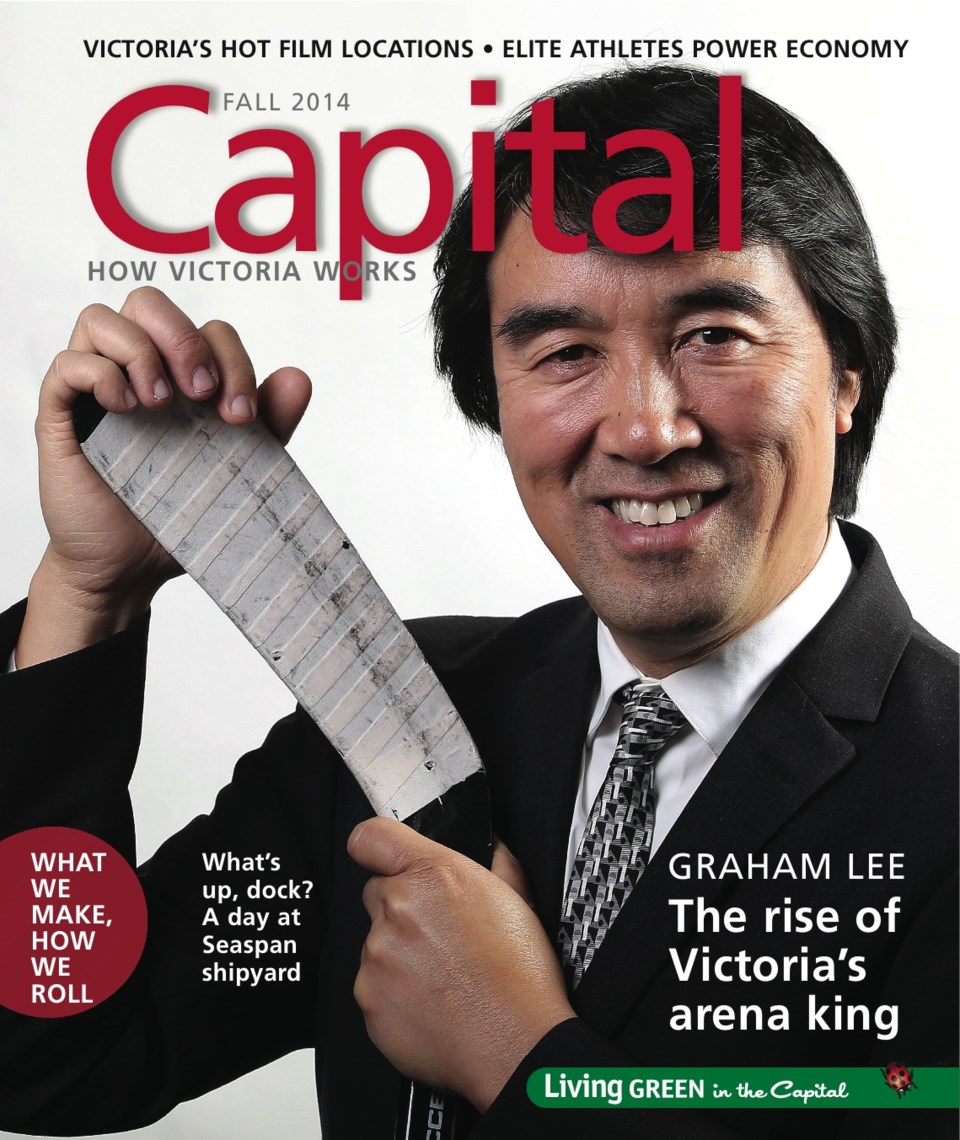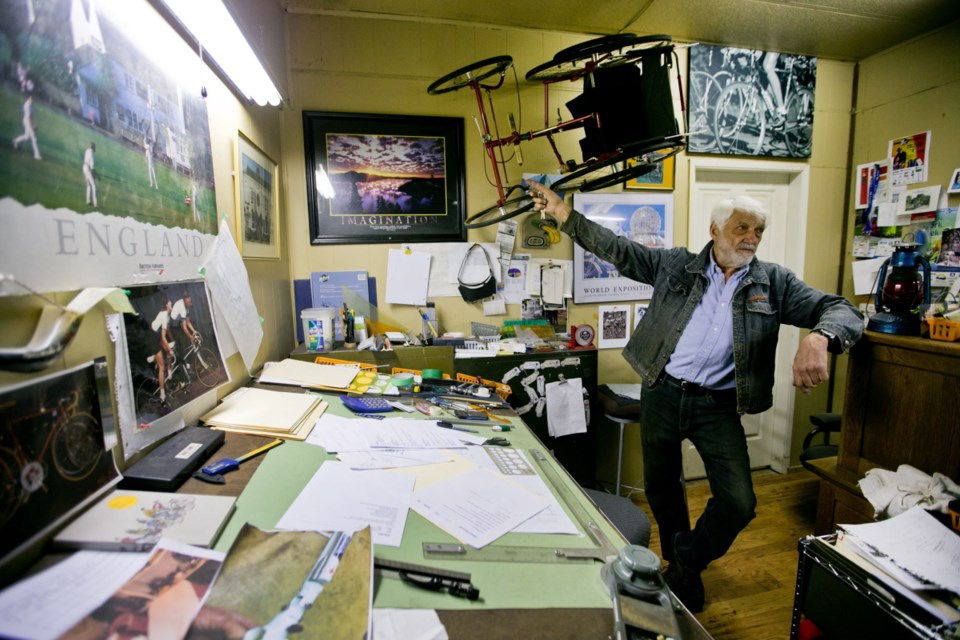Finishing the 4,495-kilometre Tour de France in 1955 was a gruelling slog.
Especially after cyclist Tony Hoar endured a spectacular wipe-out in an unlit tunnel.
“I got torn a bit,” said Hoar, now 82, recalling his flesh-tearing road-rash with typical understatement. Refusing to drop out, he was the last man to complete the Tour de France that year. This earned him the “Lanterne Rouge” designation, viewed as an honour because it’s a testament to the dogged determination of the last-place cyclist.
Today, British-born Hoar — white-bearded and genial — is as driven as ever. He still cycles regularly. Each day he designs and constructs bike trailers for his one-man business, Tony’s Trailers, typically toiling until midnight at his Mill Bay workshop. When not working, Hoar is out buying trailer and bicycle parts, sometimes making the rounds in his 1956 Morgan sports car.
Now, Hoar has a new dream. He’s lobbying hard to make it happen, tapping into the same grit that propelled him through the Tour de France.
He wants to establish what he calls an “Integrated Cycling Resource Centre” in Victoria. Hoar believes such a facility would revolutionize recycling in the downtown core. And it would help out the homeless as well.
His proposed cycling resource centre requires a large warehouse where old bicycles would be refurbished for sale, rent and loan. The centre would also construct and sell bike trailers. The latter is a field of expertise for Hoar. His custom-designed bicycle trailers, sold world-wide, have hauled everything from sailboats to 400 kilograms of recycling.
He believes the Integrated Cycling Resource Centre could also:
- serve as a bottle and can recycling depot for binners
- provide bike-powered commercial delivery services
- offer training programs for those (particularly the disadvantaged) wanting to learn about repairing bicycles and designing/constructing bike trailers
- convert discarded shopping carts into bike trailers
- provide bikes and trailers that could be used as disaster-relief vehicles
 |
|
Click on the cover to read the fall 2014 issue of Capital magazine online |
It’s more than a pipe dream. Hoar — who designed the heavy-duty wheelchairs for Rick Hansen’s 1985 Man in Motion tour — is no run-of-the-mill bike aficionado. He’s a widely respected figure in British Columbia’s cycling community. And he’s steadily gathering support for his Integrated Cycling Resource Centre, some of it from influential people.
A key ally is Jutta Gutberlet, an associate geography professor at the University of Victoria. For six years, Gutberlet led the Participatory Sustainable Waste Management project in Sao Paulo, Brazil, in which poor people collected waste for recycling, mostly using carts pushed by hand.
Gutberlet previously partnered with Hoar on a pilot project in 2008 to help homeless people in Victoria. He invented a tent-trailer for bicycles, which could be converted into a regular trailer to carry goods. Gutberlet believes Hoar’s proposed cycling resource centre would work.
“I think Victoria would be a perfect city to do something like that. It’s a medium-sized city. It has a lot of forward-thinking people. It has the university. It’s a wealthy city, too,” she said.
Gutberlet notes cities such as Vancouver and Montreal already host successful human-powered recycling programs. Vancouver’s United We Can bottle depot — which operates downtown — processes 20 million recyclable containers annually.
Another supporter of Hoar’s project is Sarah Webb, active transportation program manager for the Capital Regional District. Webb is also founder of the University of Victoria’s long-running Spokes program, which reconditions donated bicycles for loan or rental.
Webb said Hoar’s resource centre could work in conjunction with existing Victoria bike-friendly programs such as Spokes. She said immediate steps for the project would include deciding on a governance model (for instance, forming a co-operative) and finding a partner (government or private sector) for the warehouse facility.
“Based on all the research, on examples and demand of what exists in Victoria, there’s no reason why a cycling centre like this couldn’t be a huge success,” Webb said.
“We’ve just started pulling [Hoar’s project] together. The CRD and other local government agencies will be engaged in the future, I think. But for right now, we’re still putting our ducks in a row.”
As far as bike-powered recycling goes, the biggest success story on Vancouver Island has been Cowichan Recyclists. The business, founded in 2007 by Aaron Bichard and Katie Harris, recycles waste for 110 businesses in Duncan. They use four trailers constructed by Hoar, ranging in length from 1.2 to 2.4 metres. Using two trailers in tandem, a cyclist can haul as much as 400 kilograms on a single load, Bichard said.
Cowichan Recyclists also operates a cargo tricycle that recycles waste in downtown Victoria.
Bichard believes the proposed resource centre would be a boon for this city. “It’s definitely a great idea and I think that kind of thing could really work,” he said.
Hoar realizes Victoria won’t convert to bicycle recycling overnight. He imagines the Integrated Cycling Resource Centre would be introduced downtown in stages, increased year by year.
“The thing is getting it going,” he said with a smile. “I’m getting more people interested.”
